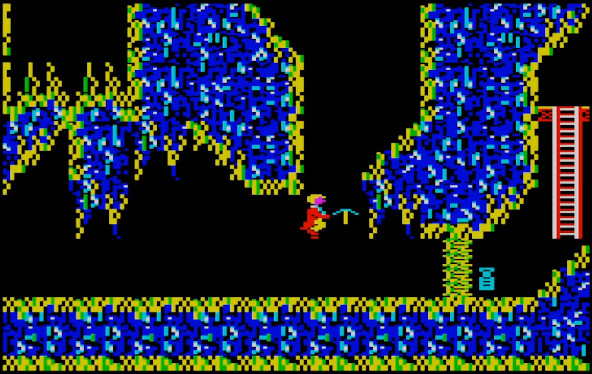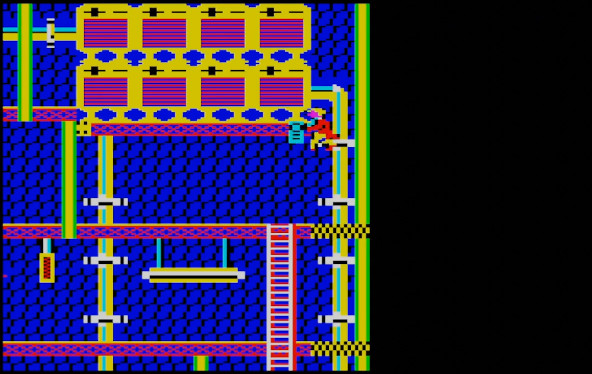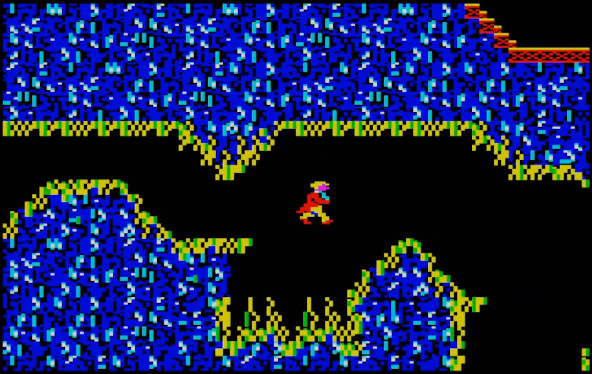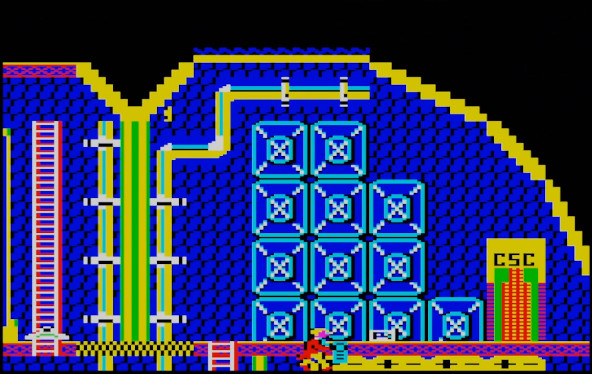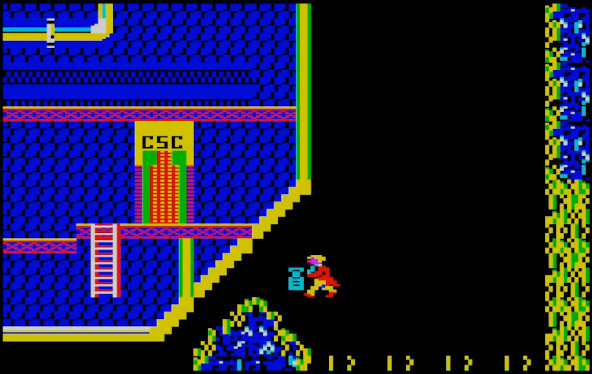
Speedrun (v), [ˈspiːdrʌn] - to complete a computer game, or part of that game, in the fastest time possible, given a set of restrictions.
This is a little formal, so let me give you an example. If you've ever played a racing game's time-trial mode for individual tracks, then you've done a speedrun. It's about honing skills and abilities to eke out time-savings along the way. But speedrunning tends to be a lot more than that, involving special tricks, strategies and even glitches to reach the goal of the run as quickly as possible. All of this is known as 'speedtech', which covers anything that can be used, within the rules of the run, to aid going fast.
The following will accrue accounts - with video - of some of the older games I have personally routed and run. Games from the 80s and 90s that hold a special place in my heart.


Micro Power (1985) - for the BBC Micro
Part 1
Overview and Background:
The Mines of Terror is a Doctor Who adventure for the 8-bit home computer. First released for the BBC Micro, then later for the Amstrad and the Commodore 64, the game was originally conceived as a sequel to the BBC Micro classic, Castle Quest. Given the game's title, you won't be surprised to find out that this didn't happen and the game was later re-conceived as an official Doctor Who game.
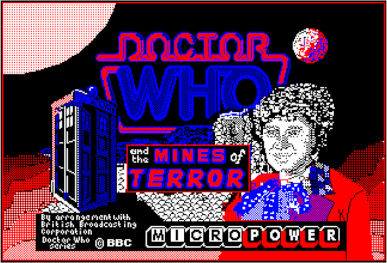
In the genre of a puzzle-platformer, you are in control of Colin Baker's incarnation of The Doctor, the Sixth. The story is a bit convoluted, but let me try and summarise.
Plot Summary:
The Time Lords have discovered a plot to abuse a 'Time Instant Replay Unit' - from here on known as 'The MacGuffin' - on the second moon of Rijar. The moon's mines produce an element essential to the creation of the MacGuffin, Heatonite. It's up to The Doctor to deal with it.
But oh no! It turns out this whole thing has been a dastardly and bastardly plan by The Master all along who is, for some reason, cosplaying as the devil - don't ask. He wants to use The Doctor's brain in the MacGuffin to somehow turn it into a device for controlling events in time. I don't know why a Time Lord with a time machine can't do this already, but I'm sure it doesn't really matter.
On your journey through the mining complex, refineries and labs you'll need to solve puzzles, avoid deadly enemies and recover the MacGuffin. You'll encounter the TARDIS, The Master, with his time machine in the form of an Ionic column, and several other death-defying situations that will require the quick wits of The Doctor to survive.


Routing The Run:
Approaching a game with a mind to speedrun it requires looking at the game in a very different way from normal. Knowing the mechanics of the game is important, but that's because you can't subvert those mechanics if you aren't familiar with them. The first thing is to ascertain the minimum number of things the game expects of you to count as 'completion'.
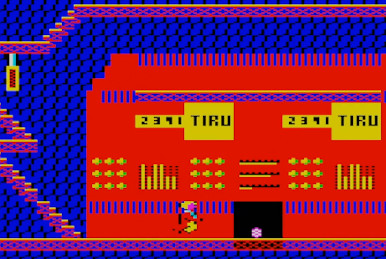
With this in mind, I had to find a way of achieving those simple-sounding goals in as quick a time as possible. During a casual play-through of the game you might notice some odd behaviour every now and then, The Doctor moving in strange ways, or the game reacting to edge cases in an unexpected way. Things like that are exactly what I'm looking for to help me. It was time to search for any quirks in the game that I could exploit to my advantage.
Glitch Hunting:
The gameplay of a glitch hunter might look borderline insane if viewed in isolation - continually jumping at walls, repeatedly dying, etc. - but there is method to the madness. Finding out exactly why that 1 jump from a ladder in 100 gives you extra distance, say, could lead to accessing parts of a level that you weren't intended to, subverting a locked door or a solid wall.
In extended bouts of 'mucking about' in the game world I discovered some very interesting and, ultimately, very helpful glitches in Mines of Terror. Some of it was movement related, some of it abused geometry, and there were even areas usually 'out of bounds' to the player that I could access. The following tabulated data records all the glitches I discovered:
Building The Route:
With all these glitches under my belt, I was in a position to figure out where and when they could be used to speed up completion of the game. After much experimentation I discovered that the MacGuffin of which I sought was handily placed just above an area where a highjump could clip me through the ceiling - good news. Bad news - I'm now trapped in a locked off area with killer not-Daleks and no way to get out.

Lucky then that I pass a CSC on the way to ceiling clip up to the MacGuffin. By tagging it, grabbing the MacGuffin, storing it in the inventory, then walking face-first into a murder-bot, I escape the locked-off area and bring what I need with me. Then all I need to do is to take it to the TARDIS, which, by the time the player has done everything required to get the MacGuffin, should have moved into The Master's lair.
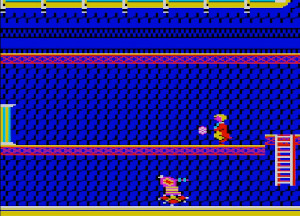
But just because the TARDIS graphics aren't there, it doesn't mean that the hit-box you interact with to complete the game isn't there. In fact, it is. If you use the MacGuffin at the point shown in the picture, (inset left) then you complete the game whether the TARDIS graphic is there or not.
If only getting there was as easy. Unfortunately The Master's lair is behind a lot of puzzle solving to get there legitimately and, even worse, is entirely surrounded by the harsh near-vacuum of the small moon's meagre atmosphere. No chance of jumping through a ceiling if we're turning inside-out before we get there. But there is a solution.


There was one place. A single piece of the landscape that was within jumping reach. The Master thought he had this all locked up tight, but he didn't count on me wall jumping onto impossible to reach platforms, jumping through ceilings until I found myself in an escape pod launch tube, phasing through the roof with an oxygen tank in hand, falling a fatal distance whilst also moving through the air in defiance of physics and surviving, before passing through a wall as if it wasn't there are sneaking away via an invisible TARDIS. The fool.
Running The Run:
So that's what I did. Surviving a monster, 'The Madrag', that lives in the deep caves where the Oxygen Cylinder is found required some quick Splinx programming - bothering its eggs so as to distract it - but the keystrokes become second-nature with enough practise.
With it all put together I started performing runs. I quickly learned that my route was viable and could be reproduced consistently, so I set about pushing for a competitive time. I say 'competitive', I mean 'presentable'. Nobody else, according to Speedrun.com, had ever run the game, although a hopeful Doctor Who fan had created the leaderboard in anticipation. I completed runs, but none that didn't have some glaring problem, something I could improve on, a trick that didn't work first time, etc.
Hypo
or click Here to return to the main page.


Micro Power (1985) - for the BBC Micro
Part 2
Riding The High:
In the first part of my speedrunning tale I revealed all of the glitches and quirks of the game that I found. I was quite pleased with myself for all of that. Even more pleasing was how all these things came together to create a run that, even for people unfamiliar with the game, looked both fun and broken. Check out the video to see my point proven.




[*Technically]
Ruining Everything:
Yes, finding new speedtech is part and parcel of the speedrunner's trade. All of the glitches that were discovered in Part 1 complemented each other in such a way as to produce a fast, challenging and fun speedrun. But this is a speedrun, not a glitch showcase and just because we've managed to construct a run doesn't mean it can't be 'improved'.
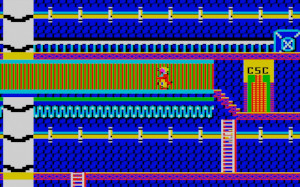
But then I had an idea. One of those niggling ideas that seemed ridiculous. Even more ridiculous was why I hadn't thought of trying it before. You win the game by bringing the Time Instant Replay Device (TIRU aka The MacGuffin) back to the TARDIS within The Master's lair. But the TARDIS doesn't start in The Master's lair, the game begins with The Doctor having just stepped from it. It's right there in the mines. So could I return the MacGuffin to the starting TARDIS position?
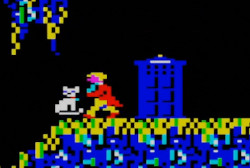
As an aside, it's actually, not that ridiculous that I hadn't thought of trying it. As I explained in Part 1, the sprite showing where the TARDIS is located is independent of whether the hitbox that registers a game-win condition is present. Because, during a normal play through of the game, the TARDIS will always be moved to The Master's lair by the time you have the MacGuffin, there's no reason for a win-condition hitbox to exist in the mines.
Despite an aforementioned hitbox not having any business being there... I'm sure you can guess where this is going. I started a game and weaved my way through the not-Daleks to get up to the MacGuffin, as that was all I needed to test this insane hypothesis. With the pink orb in my possession I weaved my way back through the patrolling death-bots and, fully expecting nothing to happen, I used the MacGuffin.
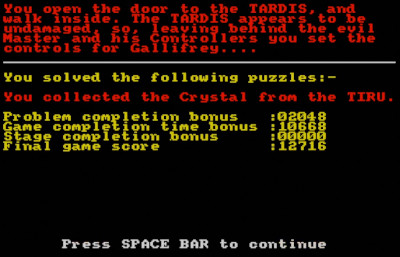
To be absolutely honest, I didn't know how to take it initially. Everything I thought I knew about speedrunning Doctor Who and The Mines of Terror was, in that moment, shattered!
I'd finished the game without going outside the complex at all, so no need to get the oxygen. That, in turn, means I don't need to get the pickaxe - its only use was to break down a wall protecting the oxygen tank. Could the new route, taking this newly discovered tech into account, really be so simple?
(Yes It Could) - The New Route:

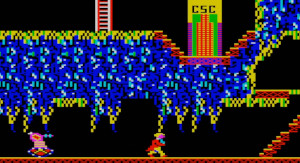
With all of this in mind, it was a relatively quick job to come up with a consistent and safe route through the parts of the robot infested mine. Make exactly the same movements and you'll have exactly the same result, every time. If only getting back could be as easy...

[*Dying in order to get somewhere faster]
So now the route has been reduced to a lot of walking, a couple of tricks and an intentional death. Is it quick? Absolutely. Is it a fun run that has enough challenge to keep it interesting? Sadly, no. I ruined everything. 'But how fast is it Hypo?' I hear you cry. Well...
[*Technically, yes, I know]
The Future:
You can never rule out new tech that might reinvigorate the run, but you also can't count on it either. There's also no guarantee that anyone else other than me would show even the slightest interest in running the game and fleshing out the leaderboards. But it would be nice to see some others try and shave off those sloppy seconds.
Something that might be worth routing is a path to 100% the game in the fastest time possible. There are plenty of things you can do in the game to get a higher score. Getting the maximum score would certainly require all of the discovered glitches, and could return the challenge and the fun to the speedrun. It would, of course, have to be separated from the above Any% route, but I can see that being worthwhile.

(Opens in a new browser window)
It's been fun to look back on this speedrun and properly document it. Not all of them have such a seismic shift halfway through (which is why it felt acceptable to split it into 2 parts), but every game I have speedrun has been a different experience.
Until my next exciting tale of speed, farewell.
Hypo
or click Here to return to the main page.
